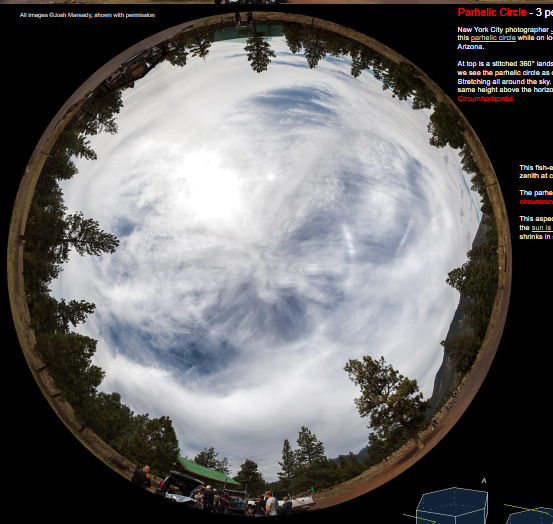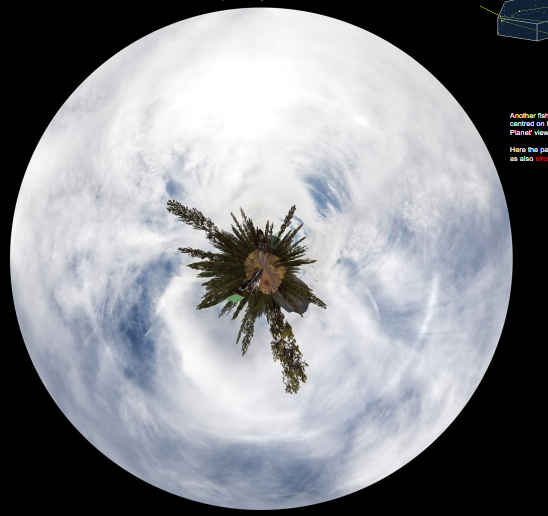Parhelic Circle, three perspectives - OPOD
Parhelic Circle: A Spectacular Atmospheric Phenomenon
The parhelic circle is a mesmerizing atmospheric optics phenomenon that often captivates skywatchers. It appears as a circular band of light encircling the sky, parallel to the horizon. In this article, we will explore the parhelic circle from three perspectives, shedding light on its formation, characteristics, and unique viewing angles.
Perspective 1: The Circumhorizontal View
Photographer Josh Maready captured a stunning image of the parhelic circle during his time in Flagstaff, Arizona. In his panoramic shot, the parhelic circle is prominently displayed as a white band stretching across the entire sky. This perspective, known as the circumhorizontal view, reveals the circle at the same height above the horizon as the sun. It gives us a comprehensive understanding of the parhelic circle's extent and its circumferential nature.
Perspective 2: The Circumzenithal View
When observing the parhelic circle from a fish-eye view with the zenith at the center, an intriguing perspective emerges. This viewpoint showcases the parhelic circle as circumzenithal, meaning it appears directly above the observer's head. The strength of this aspect is most pronounced when the sun is high in the sky, causing the circle to shrink in size. From this vantage point, the parhelic circle offers a unique and awe-inspiring spectacle.
Perspective 3: The Circumnadiral View
Another fascinating way to experience the parhelic circle is by looking at it from a "Little Planet" view, centered on the nadir. This perspective allows us to see the parhelic circle as circumnadiral, encircling the point directly opposite to the zenith. While this viewpoint may not be as commonly observed, it provides a different dimension to our understanding of this optical phenomenon.
Unveiling the Formation of the Parhelic Circle
The parhelic circle owes its existence to the refraction and reflection of sunlight by ice crystals present in high, cold cirrus clouds. For the parhelic circle to form, the ice crystals must be relatively large, measuring greater than approximately 0.05mm in diameter. Hexagonal plate crystals, horizontal hexagonal columns, and Parry oriented crystals are responsible for generating the parhelic circle's distinctive appearance.
The Complexity of Ray Paths
The formation of the parhelic circle involves a multitude of ray paths, each contributing to its unique characteristics. Among these paths, three primary ones stand out:
- External Reflection (Path A): This simple ray path results in a relatively weak parhelic circle, particularly near the sun.
- Internal Reflection (Path B): Considered the strongest contributor to the parhelic circle's formation, this path involves light internally reflecting once. As the light enters and exits the ice crystals, it splits into its component colors, which then overlap to produce the characteristic white hue of the parhelic circle. This path does not alter the altitude of the rays but causes them to deflect in azimuth, creating a circle at the same height as the sun.
- Multiple Internal Reflections (Path C): In some instances, three or more internal reflections can occur, intensifying the brightness of the parhelic circle far from the sun.
Exploring the Parhelic Circle's Full Splendor
The parhelic circle is a captivating atmospheric phenomenon that showcases the interplay between light and ice crystals. Its beauty can be appreciated from various perspectives, each offering a distinct visual experience. Whether observing it as a circumhorizontal band encircling the sky, a circumzenithal spectacle directly above, or a circumnadiral marvel centered on the nadir, the parhelic circle never fails to mesmerize.
As we delve deeper into the intricacies of this optical phenomenon, we gain a greater appreciation for the delicate processes that shape our atmospheric optics. The parhelic circle serves as a reminder of the wonders that surround us, inviting us to look up and marvel at the extraordinary displays painted across the sky.

Parhelic Circle - 3 perspectives
New York City photographer Josh Maready watched this parhelic circle while on location at Flagstaff, Arizona.
At top is a stitched 360° landscape panorama. Here we see the parhelic circle as often described. White. Stretching all around the sky. Everywhere at the same height above the horizon, that of the sun. Circumhorizontal.
All images ©Josh Maready, shown with permission

Parhelic Circle - 3 perspectives
New York City photographer Josh Maready watched this parhelic circle while on location at Flagstaff, Arizona.
At top is a stitched 360° landscape panorama. Here we see the parhelic circle as often described. White. Stretching all around the sky. Everywhere at the same height above the horizon, that of the sun. Circumhorizontal.
This fish-eye view has the zenith at centre.
The parhelic circle is seen as circumzenithal.
This aspect is strongest when the sun is high and the circle shrinks in size.

The parhelic circle (PC) is formed by sunlight refracted and reflected by ice crystals in high, cold cirrus cloud.
The crystals must be large enough (greater than about 0.05mm across) to be aerodynamically oriented. Hexagonal plate crystals form the PC, so do horizontal hexagonal columns and also Parry oriented crystals.
The PC can be formed by a great many different ray paths. Only a few are at right.
'A' is the simplest, an external reflection. It gives a rather weak PC stronger near the sun.
'B' produces the strongest PC. Light internally reflects once. It splits into its component colours at the entrance and exit refractions but the colours overlap completely along the circle to produce white (or the colour of the sunlight). The rays are deflected in azimuth but not in altitude producing a circle at the same height as the sun - or distance from the zenith.. ..or nadir.
'C' - There can be three or more internal reflections. They tend to brighten the PC far from the sun.

Another fish-eye view, this time centred on the nadir. A 'Little Planet' view.
Here the parhelic circle is seen as also circumnadiral.
Note: this article has been automatically converted from the old site and may not appear as intended. You can find the original article here.
Reference Atmospheric Optics
If you use any of the definitions, information, or data presented on Atmospheric Optics, please copy the link or reference below to properly credit us as the reference source. Thank you!
-
<a href="https://atoptics.co.uk/blog/parhelic-circle-three-perspectives-opod/">Parhelic Circle, three perspectives - OPOD</a>
-
"Parhelic Circle, three perspectives - OPOD". Atmospheric Optics. Accessed on December 18, 2024. https://atoptics.co.uk/blog/parhelic-circle-three-perspectives-opod/.
-
"Parhelic Circle, three perspectives - OPOD". Atmospheric Optics, https://atoptics.co.uk/blog/parhelic-circle-three-perspectives-opod/. Accessed 18 December, 2024
-
Parhelic Circle, three perspectives - OPOD. Atmospheric Optics. Retrieved from https://atoptics.co.uk/blog/parhelic-circle-three-perspectives-opod/.